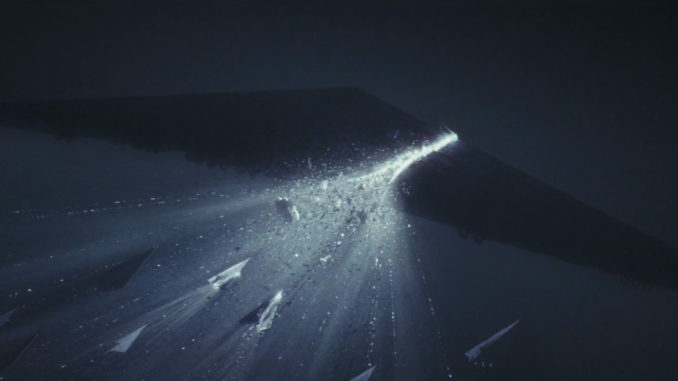
In this the fourth, and final, part of my series on hyperspace travel in Star Wars, I will finish with the game mechanics necessary to pull off some of the spectacular stunts we’ve witnessed in the movies. In the previous installation, I had begun a discussion on the Holdo Maneuver where I covered how to handle the difficulty of accomplishing a ramming operation at lightspeed. I will now pick up with the aftermath of a successful Holdo Maneuver before going to the final chapter of the Skywalker Saga, Rise of Skywalker.
Star Wars: The Last Jedi – The Holdo Maneuver (continued)
Assuming that a ship has successfully rammed its target while making the jump to lightspeed, it is now time to calculate the damage to both ships. Normally two ships colliding would suffer from either a minor or major collision with both ships taking a Critical Hit and subtracting their defense times either 10 or five from the Critical Hit determination depending on the severity of the crash. A ship colliding with a target while making the jump to lightspeed, however, gains the benefit of using its greatly increased velocity to devastating effect.
I would stat the damage for the Holdo Maneuver as follows:
Damage: (Silhouette of the ship + No. of successes) x 10, Critical 1
Special: Breach (Armor of the ship), Vicious (Silhouette of the ship), Blast (Silhouette of the ship x10)
Assuming that the Raddus had a silhouette of 8 and Armor of 9 (using stats of an MC80 Liberty Type Star Cruiser as an approximation) its successful attack on the Supremacy would have inflicted a Breach 9 hit for 90 damage. The Vicious 8 from the attack would add 80 to any roll for a Critical Hit. Additionally, Blast would trigger and any other vessels at engaged range with the target would also suffer blast damage of 80 from the collision which would not benefit from the Breach or Vicious rating of the base attack.
Based upon what was shown in The Last Jedi, I would speculate that the Supremacy took at least one or more Critical Hits including Major Hull Breach from Vice Admiral Holdo’s attack. Additionally, the escort ships with the Supremacy were also severely damaged from the blast effects of the collision. The Raddus itself was destroyed from the maneuver. As discussed in the last article, this is why this tactic is rarely used as it results in the destruction of the ship used.
A Fresh Example
Let’s use the Holdo Maneuver to simulate a Starfighter Ace (page 415, Age of Rebellion) in a CR90 Corvette crashing into an Imperial I-class Star Destroyer at lightspeed. The CR90 has a silhouette of 5 and the Star Destroyer has a silhouette of 8 and both are at Long Range from each other. The difficulty of the Piloting (Space) check for the Starfighter Ace will be two red challenge dice and one purple difficulty die with one setback die for visually lining up the attack. The Starfighter Ace will be bringing three yellow proficiency dice and one green ability die to the roll plus a setback die for the handling of the CR90. The result of his skill check is one success and one Triumph so he manages to strike the Star Destroyer at lightspeed.
The collision obliterates the CR90 and the Starfighter Ace and delivers 60 Damage with Breach 5 to the Star Destroyer. With an Armor of 10 the Star Destroyer takes 55 Hull Trauma from the attack and the Triumph can be used to inflict a Critical Hit with Vicious 5 since the armor was penetrated. A 91 is rolled for the base Critical Hit. With Vicious this becomes a result of 141 and the Star Destroyer is on fire!
Star Wars: The Rise of Skywalker
Once again we got to witness extraordinary feats of hyperspace travel courtesy of the Millennium Falcon and its enhanced navicomputer. Specifically, we got to watch Poe Dameron use a tactic called lightspeed skipping. From what has been revealed, lightspeed or hyperspace skipping, is when a ship makes a short jump to lightspeed without coordinates from a navicomputer. We can actually adjudicate the use of this tactic at the game table using the rules as written.
If someone wishes to utilize lightspeed skipping to throw off pursuers the base difficulty will be an Easy Astrogation check (one purple die) modified with three more for not using a navicomputer and probably an additional one for being a quick jump. This has made the Astrogation check for lightspeed skipping a Formidable difficulty task (five purple dice). A successful check means that the ship attempting the maneuver has evaded its pursuers while a failure means that the pursuers are able to also attempt to lightspeed skip and keep up with the lead vessel.
So what we see in The Rise of Skywalker are failed attempts by Poe Dameron to use hyperspace skipping. Each time the pursuing First Order fighters keep up with the Millennium Falcon. Along the way, the Millennium Falcon lost one or more enemy ships to collisions (Use of Advantage, perhaps?), took a lot of system strain due to Threat generated, and probably suffered at least one Critical Hit from a Despair result that caused a fire to break out. In the end, either due to attrition or a successful skip, Poe managed to evade the pursuers and return to Resistance Headquarters.
Wrapping Up
In the past four articles, I have explored what we know about hyperspace travel from its basic game mechanics to the history of its development. We have also discussed ways of interdicting hyperspace travel and weapons that function in and through hyperspace. Finally, we have explored the new tricks we have observed in the latest Star Wars movies and I’ve given my take on how to include them in your roleplaying game. I hope this helps you take your game into lightspeed! May the Force be with you!
